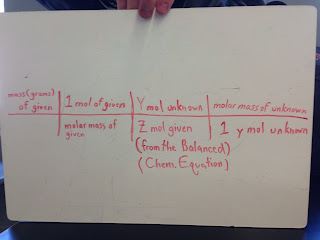Sections 2H & 4: First, write the balanced chemical equations for the problems on the worksheet we started today (2a, 3b, 4a & 5a). Then, answer the following questions in your notebook:
1.
Nitrogen reacts
with hydrogen to produce ammonia.
a.
Write a balanced
chemical equation
b.
How many moles of
hydrogen, H2, are needed to react with 2.0 moles of nitrogen, N2?
2.
Zinc reacts with
hydrochloric acid…
a.
Predict the
products of this reaction, then write and balance the equation.
b.
How many moles of
hydrogen are produced from the reaction of 3.7 moles of zinc?
3.
Write a balanced
combustion reaction for propane (C3H8)
4.
How many moles of
oxygen are necessary to react completely with 4.5 moles of propane (C3H8)?
5.
Write a balanced
chemical equation for the double replacement reaction between potassium
phosphate and aluminum nitrate.
a.
How many moles of
potassium nitrate are produced when 2.5 moles of potassium phosphate react?




